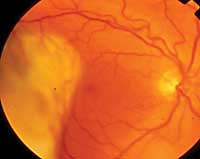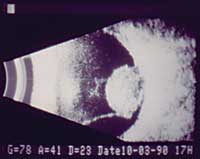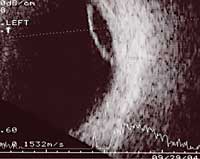New B scan ultrasound: Portable, affordable
|
|
A B scan ultrasound instrument is rare in the typical optometric office. Based upon the estimates of B scan manufacturers and random surveys at several major meetings, only about 1% of optometrists offer ultrasonography in their private practices.
Although diagnostic ophthalmic ultrasound has been around for decades, the systems were bulky and expensive. About 2 years ago, our office in Manhattan purchased a replacement B scan for about $18,000. Several weeks ago, I was asked to evaluate a new ultrasound device, tentatively called the Scanmate B-Scan from DGH Technology Inc. (Exton, Pa.), that is about to reach the marketplace. Although beyond the current standard of care, this compact, high-tech and affordable system should merit careful review by optometrists.
The Scanmate B-Scan consists of only a B scan probe that plugs into virtually any computer via a USB port. My technician installed the software in 3 minutes, and then we compared the two systems on a series of patients. Remarkably, the image quality appeared to be of higher resolution with the new Scanmate than with the traditional B scan, and it is only a third of the price.
B scan adds to technology
In our specialty practice, virtually all of our patients have fundus photos because nearly all have some retinal disorder, glaucoma or both. In addition to fundus images obtained with Optomap Retinal Exam (Optos Inc., Marlborough, Mass.), Visucam (Carl Zeiss Meditec, Dublin, Calif.) or the ARIS/Advanced Retinal Imaging System (Visual Pathways, Prescott, Ariz.), we use the Stratus OCT (Carl Zeiss Meditec) extensively in patients with macular degeneration, macular holes, vitreal-retinal traction syndrome, diabetic maculopathy or any mass lesion.
Although we use the OCT far more than our B scan, we find the B scan essential in a myriad of cases. Beyond cost considerations, some ODs may not appreciate the various clinical applications a B scan ultrasound offers. I discovered more than 200 ICD-9 codes for ophthalmic ultrasound, diagnostic B-scan (CPT 76512).
Malpractice case
My support of the use of the B scan stems from several malpractice cases where I served as an expert witness. In a case that has had the greatest impact on me, an asymptomatic myopic 45-year-old white man came for the first time to an optometrist. The optometrist noted and sketched a 1 disc-diameter choroidal nevus in the superior temporal arcade in the right eye. Because the patient was moderately myopic with lattice degeneration, the OD told him to return as soon as possible if he ever noticed flashes, floaters or curtains.
About 1 year later, the patient returned to the office because he experienced flashes. The practice’s retinal specialist dilated the patient’s right eye and found a retinal detachment but observed that it was secondary to a giant amelanotic malignant melanoma. A B scan of the lesion clearly revealed both the mass and the secondary retinal detachment. The most posterior border of the mass matched the position in the drawing of the “nevus” made 1 year earlier. The patient was referred to an expert in Boston who confirmed the diagnosis.
The patient underwent proton beam irradiation that resulted in tumor regression, but follow-up revealed liver metastasis. The patient died several years later despite aggressive and experimental treatment in Boston and at the National Institutes of Health.
During the optometrist’s deposition, she testified that she observed the “nevus” and then drew it but also took fundus photos. However, the record did not reflect this, the patient was never billed for fundus photography and the alleged photos were never located. Although the experts for the defense testified that the care rendered met existing standards in diagnosis and follow-up of a choroidal nevus, the case was settled out of court quietly for several million dollars.
New recommendations
|
Images: Sherman J |
Based upon this case, in my practice we now recommend that a nevus noted in a new patient — or one in an existing patient but observed for the first time — be photographed. We also recommend re-evaluating the patient in 3 months to ensure that the lesion has not grown.
The Optomap is especially helpful in these cases because a nevus will be visible on the red separation channel but will disappear on the green. Even lesions anterior to the equator can easily be imaged. B scan ultrasound can also be obtained to quickly confirm that the lesion is indeed flat.
A typical nevus cannot be detected with a B scan and hence a negative B scan helps confirm the presence of only a nevus. A B scan can detect lesions that are typically more than 2 mm thick and are highly suspicious for choroidal malignant melanoma. The larger the lesion and the more irregular and ominous its appearance — such as orange pigment on its surface — the less likely the B scan will be normal. OCT is also helpful in documenting lesion thickness, and all three technologies (fundus photos, B scan and OCT) can monitor change over time.
More recent case
A second case exposes a new dilemma. A 29-year-old female myopic contact lens wearer complained of flashes and floaters. However, these symptoms were disputed by her optometrist. Because the patient revealed that she was in the first trimester of her first pregnancy, the optometrist recorded under ophthalmoscopy, “DFE [dilated fundus exam] deferred until after pregnancy.”
Following a routine delivery of a healthy newborn, the patient returned as instructed, was now dilated and found to have a malignant melanoma anterior to the equator in one eye that was not observed previously through the undilated pupil. Because of the large tumor size at diagnosis, the eye was enucleated. She is currently under careful follow-up because of the substantial metastasis risk.
Although many optometrists dilate women in their first trimester, an estimated equal number feel that introducing any medication such as dilating drops is just not worth the risk, even if small or non-existent.
Case may create new standard
Some have suggested that Optomap is ideal in such a case because images of about 200° are obtainable even without dilation. B scan ultrasound, although not capable of detecting a small peripheral tear, will detect a retinal detachment or a mass lesion.
One of the experts in this second case opined that either Optomap or B scan would have detected the melanoma during the first trimester (or nearly a year earlier), and that both are considered safe during pregnancy. Should an optometrist without either Optomap or B scan refer a pregnant patient to a colleague with such technology? The outcome of this case may establish a new standard of care.
Of the more than 200 ICD-9 codes that apply to ophthalmic ultrasound, diagnostic B scan can be used to diagnose common disorders such as benign neoplasm of choroid or choroidal nevus (224.6), which is present in about 2% to 9% of patients; retinoschisis (361.10), which occurs in about 1% to 4% of patients; and any old or new retinal detachment, either partial or total.
Many retinal surgeons will obtain B scan prior to retinal detachment surgery just to document that the retinal detachment is not secondary to a space occupying mass such as a choroidal melanoma. B scan is ideal to differentiate a solid mass from just a membrane such as in a retinoschisis or retinal detachment.
Obtaining a B scan is also often appropriate in a corneal foreign body (930.0) case primarily to rule out another foreign body — especially a metallic one — that has penetrated the eye and can result in siderosis bulbi or retinal detachments, both ocular urgencies. Several malpractice cases concerning the failure to diagnose an intraocular metallic foreign body following trauma are in various stages of litigation.
B scan for media opacities
The use of the B scan is ideal in a myriad of media opacities that interfere with an adequate fundus view. These include corneal dystrophy (371.50) as well as other corneal opacities, dense cataracts (366.17) as well as after cataracts or opacification of the posterior capsule (366.50) and vitreal hemorrhage (379.23) and other vitreous opacities (379.24).
In cases of proptosis or exophthalmos (376.21-376.36), B scan can be used to rule out an orbital tumor. In instances of blurred disc borders, B scan can document disc elevation if present and help in the differential diagnosis of papilledema (377.00) from disc drusen (377.21).
In eyes with small pupils that fail to dilate adequately (or miosis not due to miotics – 379.42), B scan is similarly quite helpful. As highlighted above, in a pregnant woman in the first trimester, B scan can be used if the patient or doctor declines dilation because of the perceived risk to the fetus. Note that ultrasound to the fetus directly through the abdomen is considered safe and hence ultrasound to the eye is not considered a risk by virtually all obstetrician/gynecologists because of its distance from the fetus.
B scan improves care
In my personal experience, having B scan available at both the Eye Institute and Laser Center and at State University of New York University Optometric Center over the past several decades has allowed me to provide more comprehensive and better care to thousands of patients. In one patient with a diagnosis of atypical central serous chorioretinopathy that failed to resolve over several years, a B scan clearly demonstrated a malignant melanoma that invaded both the macula and optic nerve and masqueraded as central serous retinopathy. A previously obtained fluorescein angiogram was interpreted as atypical central serous. Unfortunately, not obtaining a B scan a year or so earlier may have contributed to the patient’s death.
Now that B scan is truly compact, easy to use and interpret, portable and affordable, it is likely that many optometrists will consider acquiring this new technology. Although B scan ultrasonography is considered to be a procedure that is beyond the current standard of care, going beyond the existing standard is often the best defense to prevent malpractice allegations. Perhaps other technologies will soon be available that are portable and plug into a USB port of any computer around the office.
High-tech, affordable equipment that permits us to provide better care, reduces our risk of malpractice allegations, allows reimbursement for a range of diagnostic codes and takes up no additional space is what many of us have patiently awaited.
For more information:
- Jerome Sherman, OD, FAAO, a member of the Editorial Board of Primary Care Optometry News, is the Distinguished Teaching Professor at the State University of New York and in private practice at the Eye Institute and Laser Center. He can be reached at SUNY College of Optometry, 33 West 42nd St., New York, NY 10306; (212) 938-5862; fax: (212) 780-4980; e-mail: jsherman@sunyopt.edu. Dr. Sherman is presently comparing the Scanmate to traditional B scans and hopes to expand this study with funds made available from industry. He has lectured frequently for Carl Zeiss Meditec and Optos. Marc Sherman is a senior at the University of Michigan and has just completed a book with his father, Ophthalmic Ultrasonography: B-scan for beginners.




